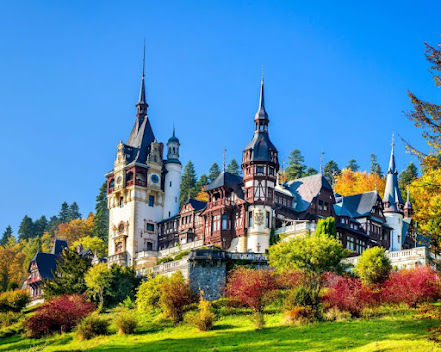During his reign, King Carol I led Romanian troops during the Russo-Turkish War and assumed command of the Russo/Romanian army during the siege of Plevna. In 1883 the king entered a top-secret military alliance with the Austro-Hungarian Empire. When World War I broke out, however, Romania remained neutral and in 1916 joined the Allies.
====================================================================(in the Carpathian Mountains, near Sinaia, in Prahova County) Peleș Castle is found northwest of the town of Sinaia, which is 48 km (30 mi.) from Brașov and 124 km (77 mi.) from Bucharest, Romania's capital. The town of Sinaia, in east-central Romania, lies in the Prahova River valley, at the foot of Mount Furnica in the Bucegi Massif of the Transylvanian Alps. In 1695 a knight, Mihai Cantacuzino, built a monastery here and named it Sinaia after a monastery on Mount Sinai in the Sinai Peninsula. The 160-room Peleş Museum is the former summer residence of the Romanian royal family. The neighboring Pelişor Palace has English-style landscaped gardens with exotic plants and conifers.
+ Nestled in a slender fir-clad valley, Sinaia now teems with hikers in summer and skiers in winter. Backed by the imposing crags of the Bucegi Mountains, it is a dramatic place for a hike for the day, (or, using the network of cabanas open to walkers), several days.
+ Peles Castle (featured here) was the summer home of Romania’s first king, Carol I. A neo-classical masterpiece, Peles Castle (or "Castelul Peles") was the summer home of the Romanian royal family from 1883 until 1947. Nestled within the Carpathian Mountains, Peles Castle was built along an existing medieval route that linked Transylvania and Wallachia -- and is today considered to be one of the most beautiful castles in Europe. The complex is composed of three monuments: Peleș Castle, Pelișor Castle, and the Foișor Hunting Lodge. (Although Sinaia is administratively part of Wallachia, it is most easily reached from Transylvania.)
+ Commissioned by Carol I, independent Romania’s first king, Peles Castle was constructed between 1873 and 1883 in a neo-Renaissance style with Fachwerk facades. Peles Castle was the first European palace ever to be powered by electricity (created in its own power plant) and to have central heating. Carol I also built another castle (Pelisor Castle) on the grounds of Peles Castle. Other buildings within these grounds include the Hunting Lodge, the Royal Guard House, the Gardener’s House, and the Royal Stables.
+ After King Michael’s forced abdication in 1947, the Communist regime seized royal property including Peles and opened the castle as a tourist attraction. Declared a museum in 1953, Nicolae Ceausescu closed the estate after 1975 because he did not like it. (The castle remained closed until the 1989 Revolution when Peles Castle was made a heritage site and reopened to the public.) With a wealth of artwork, including thousands of paintings and sculptures, (Peles Castle now houses the Muzeul National Peles.)





No comments:
Post a Comment